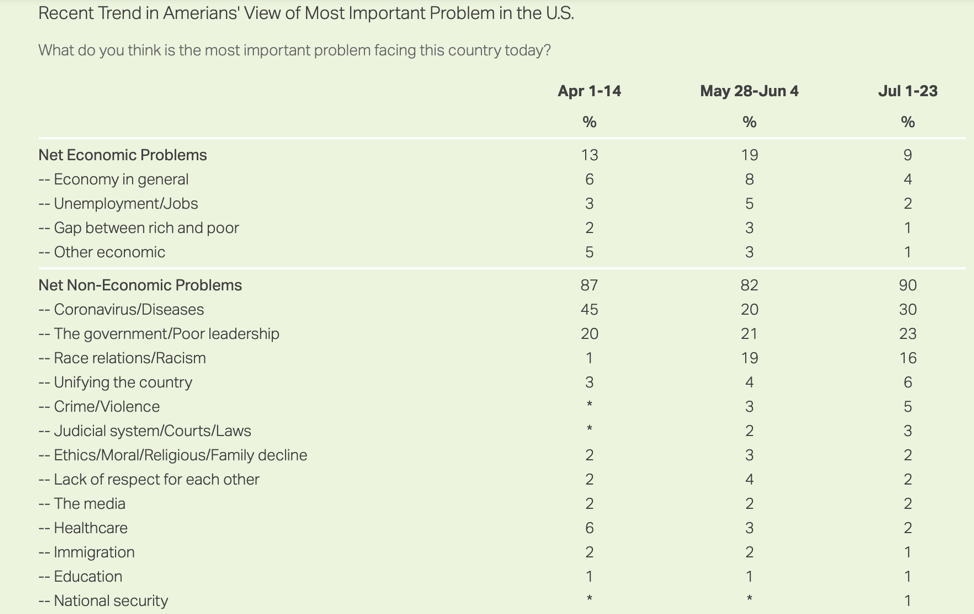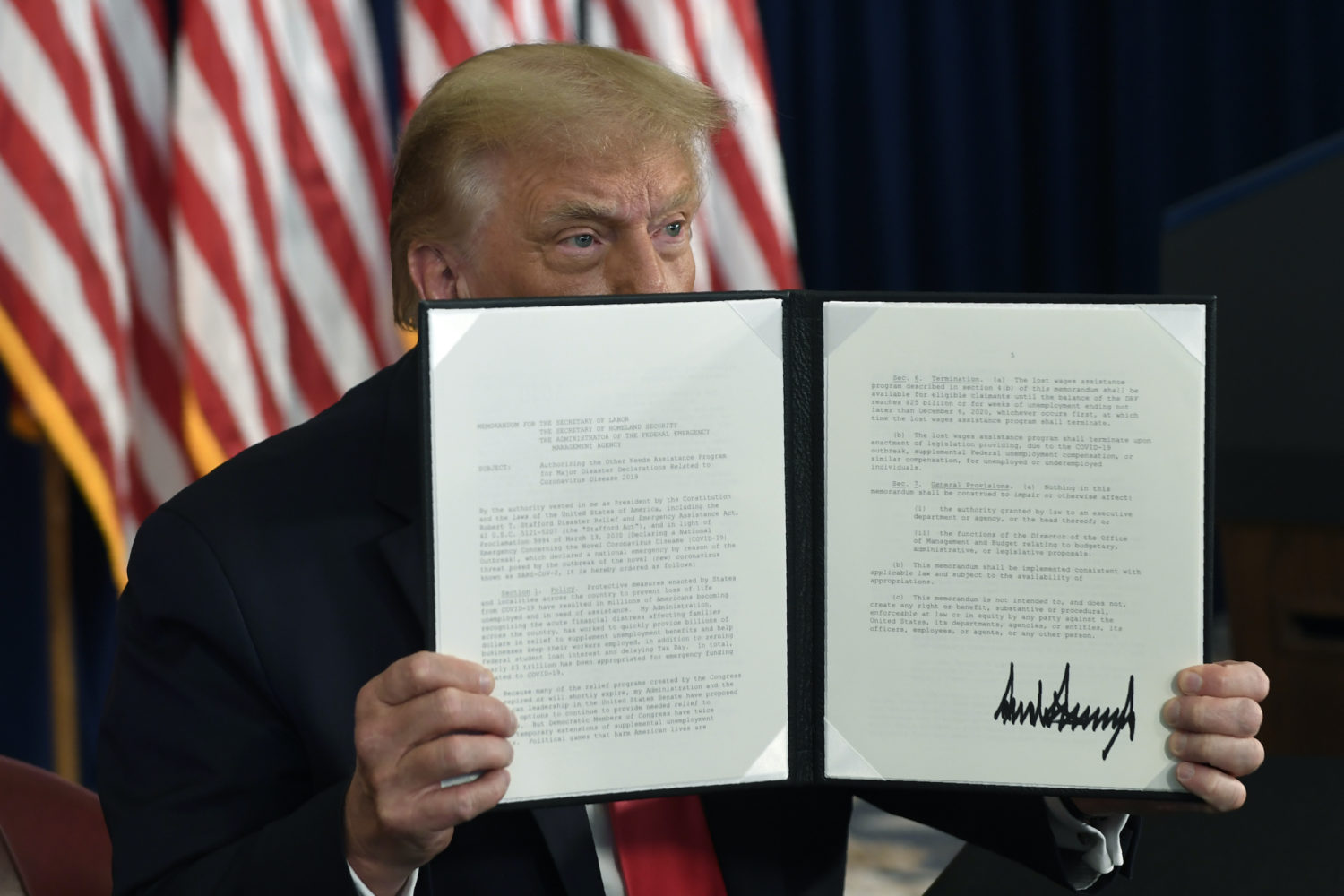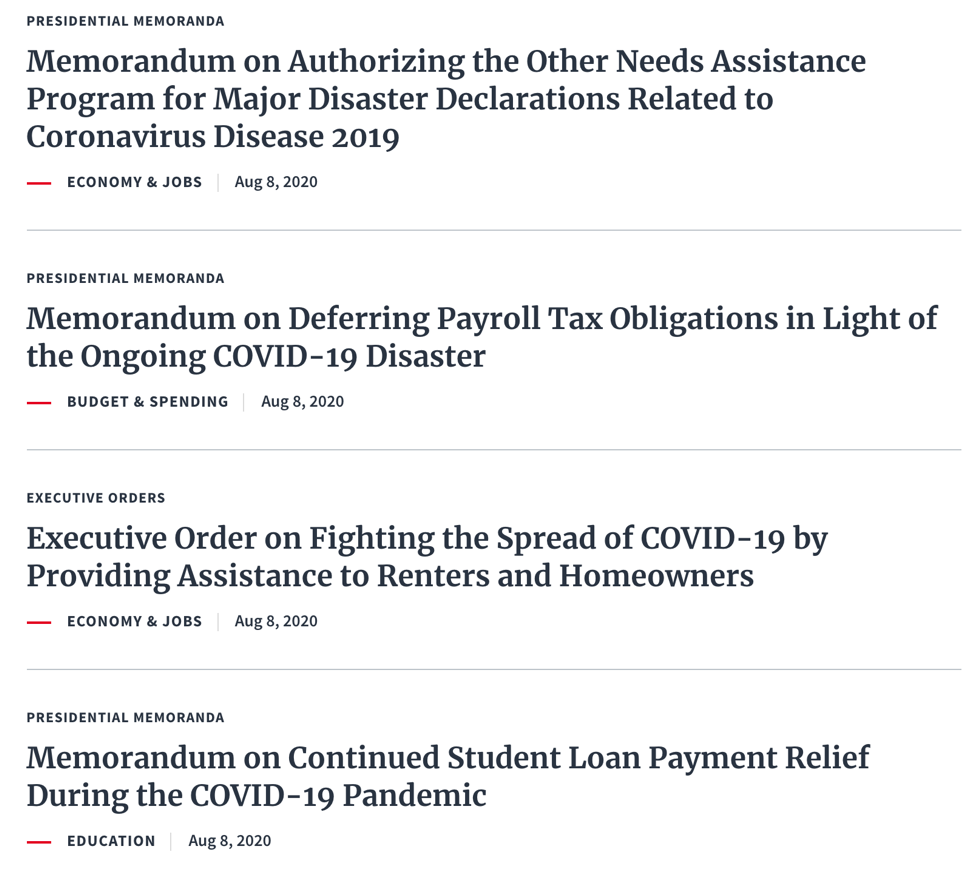 Covering COVID-19 is a daily Poynter briefing of story ideas about the coronavirus and other timely topics for journalists, written by senior faculty Al Tompkins. Sign up here to have it delivered to your inbox every weekday morning.
Covering COVID-19 is a daily Poynter briefing of story ideas about the coronavirus and other timely topics for journalists, written by senior faculty Al Tompkins. Sign up here to have it delivered to your inbox every weekday morning.
The public needs your focused attention right away to help clarify what, if any, help is on the way after President Donald Trump signed orders relating to the pandemic this weekend.
The president did not cut taxes, did not reinstate the federal unemployment program, did not issue new stimulus checks and did not forbid evictions or foreclosures. He signed one “Executive Order” and three “memoranda.”
The president’s memorandum creates a new unemployment benefit, but states will have to come up with money to make it real. The president’s order creates a new program that would pay $400 a week in federal unemployment benefits but would require states to pay $100 per week to the individual at the same time.
The states could request money from the Federal Emergency Management Agency, which is not an unfamiliar requirement for states to use FEMA funds. States generally have to match federal disaster funds 25%. The president’s order directs states to tap into the unspent Coronavirus Relief Fund, which is still largely unspent, but states said they have plans for that money. By some estimates, if the states do use the Coronavirus Relief Fund to pay their 25%, they might have enough money to pay five weeks of benefits.
This whole proposal is significantly more complicated than the relief package that expired. Even if it does not face legal challenges, which are expected, and even if states can come up with the matching money, it may take weeks or even months to get it rolling.
Ohio Gov. Mike DeWine said Sunday that “we are looking at it” to determine if his state can find the money to supply the 25% match.
White House economic adviser Larry Kudlow told CNN Sunday that the administration will be talking with states Monday to find out how many can find a way to come up with the 25% match. He admitted that the states had not agreed to the match prior to President Trump signing the memorandum. Despite that, Kudlow said he thinks the first checks could “be in a matter of weeks.”
House Speaker Nancy Pelosi said Sunday that states don’t have the matching money.
There is not yet a stimulus check on the way. It is the one stimulus action that touches the most people and, while there probably will be some agreement on sending a second round of checks to Americans, it is still in the air. But it is important that the public understand there is no immediate relief on the way.
A temporary delay in payroll tax liability means you might see more money in your paycheck but, at some point, you will have to pay it back. The president, in this case, issued a “memorandum” directing the secretary of the treasury to stop collecting some federal taxes on wages from Sept. 1 through the end of the year. It is not a tax cut, it is a deferral — meaning whatever you do not pay now you will pay later.
The tax that President Trump’s order suspended is what you see on your paystub listed as “FICA” (which stands for the Federal Insurance Contributions Act).
You pay 7.65% of your salary to FICA, which funds both Social Security and Medicare. Your employer matches your withholding, meaning the total withholding is 15.3%. (For Social Security, you pay 6.2% of your earnings up to $137,700 for 2020. If you hit that wage, any further income is not taxed for Social Security. For Medicare, you pay 1.45% of your earnings but there is no wage limit. That means 7.65% is not a universal rate because some people who earn a lot more than average pay a lower overall percentage.)
An earlier relief measure allowed employers to defer their FICA payments until next year.
As an example, a person making $50,000 a year earns $961 a week. 961 times 7.65% equals $73 a week. Kudlow said it would mean about $1,200 per worker by the end of the year, on average. Keep in mind that this deferral would affect people who are working, not those who are out of work. And keep in mind, this is a deferral, meaning it will have to be repaid sometime.
However, the president’s memorandum directs the treasury secretary to “explore avenues, including legislation, to eliminate the obligation to pay the taxes deferred pursuant to the implementation of this memorandum.”
The deferral is different from imposing a tax. That difference is what the Trump administration believes allows the Treasury Department to defer the tax collection. Congress, and only Congress, can levy taxes.
There are lots of opponents of this idea, Democrat and Republican. The two main issues are that it only helps people who are getting a paycheck and that it hurts the Social Security and Medicare budgets, both of which already are under pressure.
The “eviction moratorium” executive order does not freeze evictions. It is filled with recommendations that the government do all it can to help people who need help. But it does not block evictions.
The order says, “The Secretary of Health and Human Services and the Director of CDC shall consider whether any measures temporarily halting residential evictions of any tenants for failure to pay rent are reasonably necessary to prevent the further spread of COVID-19 from one State or possession into any other State or possession.”
“Shall consider” is not a freeze on evictions.
The order also says, “The Secretary of the Treasury and the Secretary of Housing and Urban Development shall identify any and all available Federal funds to provide temporary financial assistance to renters and homeowners who, as a result of the financial hardships caused by COVID-19, are struggling to meet their monthly rental or mortgage obligations.”
Telling a federal agency to find money to help sounds a lot like “the government shall do its job and help all it can.” But it is not a new program.
And finally, the order says, “The Secretary of Housing and Urban Development shall take action, as appropriate and consistent with applicable law, to promote the ability of renters and homeowners to avoid eviction or foreclosure resulting from financial hardships caused by COVID-19.”
Once again, it is not new that the government might do what it can to help prevent foreclosures and evictions.
The president signed an order that defers federal student loan payments through Dec. 31 and does not tack on interest for those loans while they are deferred. Again, it allows debtors to put off paying student loans. It does not forgive loans, but it does not impose a penalty for waiting longer to pay them back. This is one measure that does not appear to have significant opposition or legal questions about whether it will stand.
The orders do not provide new help to small businesses. The Payroll Protection Program expired this weekend. Since April, it has infused a half-trillion dollars into the economy with loans that, for many businesses, became grants to keep them running.
This weekend, Senate Republicans suggested extending the PPP for businesses with fewer than 300 employees that have lost 35% or more of their revenue in the pandemic. The bill would also set aside billions for local lenders to loan to businesses with fewer than 10 employees that have lost more than a third of their business. But for now, these are all ideas, not law.
Journalists will do the public a great service if they read and understand these orders and recommendations. Brevity is your enemy when reporting about nuance and complexity. Be careful not to oversimplify what these orders do and don’t do in headlines and social media posts.
Your audiences depend on your reporting to tell them whether they will be able to pay their bills and whether they will have a place to live if they can’t. And part of your job is to keep the heat on elected officials to get back to work negotiating real relief measures.
What are people concerned about right now?
One way to know what is on your viewer/listener/reader’s minds is to monitor tracking surveys about “the most important problems in the U.S. today.” Gallup has been tracking this question for years and this month’s list is informative.

(Gallup)
The biggest issue is, of course, the pandemic. But the issues of government leadership and race relations remain high in people’s minds.
Even more interesting, to me, is how people have become distracted from caring as much about climate change, immigration, student debt and health care reform, which in February were top-of-the-chart issues. This chart may be a guide for you to consider what needs more coverage to be sure that we do not lose track of critically important issues.
One school won’t monitor students when they arrive, but will monitor their sewage
The Columbia Tribune tweeted: “#Mizzou won’t test students at the front end as they arrive by jabbing a swab into their noses; Instead, MU will test at the back end, by monitoring wastewater from residence halls for signs of the virus.”
Despite my sophomoric mind, which laughed at testing “at the back end,” the idea behind the university’s sewage testing is to spot the virus before it starts showing up in clinics days later.
Are airlines safer than we thought?
The key to this question is at the end, but there have not been any COVID-19 super-spreader incidents that started with U.S. airlines so far. SO FAR.
Contact tracers have found some limited one-to-one COVID-19 spreading linked to flights but nothing that looks like a super-spreader. In April, we saw several stories of COVID-19 cases and deaths involving airline and security workers. But whether those cases were linked to flying was less certain.
A flurry of research projects in the early days of the pandemic tried to figure out how COVID-19 might spread through a plane. Kaiser Health News pointed out that a “grab bag” of airline policies add to passenger confusion and distrust that air travel is safe. The U.S. Department of Transportation issued a 44-page set of “recommendations” for airlines but does not enforce those suggestions.
But the experts say they would consider a couple of factors before flying, like how long the flight is (since longer exposure is riskier than shorter exposure) and whether the airline is leaving middle seats open (since social distancing is a factor in spread as well).
Bloomberg Opinion included a piece that said:
Arnold Barnett, a professor of management science at the Massachusetts Institute of Technology, has been trying to quantify the odds of catching COVID-19 from flying. He’s factored in a bunch of variables, including the odds of being seated near someone in the infectious stage of the disease, and the odds that the protection of masks (now required on most flights) will fail. He’s accounted for the way air is constantly renewed in airplane cabins, which experts say makes it very unlikely you’ll contract the disease from people who aren’t in your immediate vicinity — your row, or, to a lesser extent, the person across the aisle, the people ahead of you or the people behind you.
What Barnett came up with was that we have about a 1/4,300 chance of getting COVID-19 on a full 2-hour flight — that is, about 1 in 4,300 passengers will pick up the virus, on average. The odds of getting the virus are about half that, 1/7,700, if airlines leave the middle seat empty. He’s posted his results as a not-yet-peer-reviewed preprint.
Still, when The Boston Globe quizzed epidemiologists about whether, considering all that they know about COVID-19, they would fly, 13 of 15 of them said they would not.
The Centers for Disease Control and Prevention said, “Most viruses and other germs do not spread easily on flights because of how air circulates and is filtered on airplanes. However, social distancing is difficult on crowded flights, and sitting within 6 feet of others, sometimes for hours, may increase your risk of getting COVID-19.”
Almost all commercial planes have high-grade HEPA filters (high-efficiency particulate air) that can remove up to 99.999% of airborne particles.
While flying, the air coming out of the air vent is actually a mixture of filtered fresh and recirculated air, where the recirculated stuff increases the air humidity — and your comfort. It may even be healthier than in most office buildings, schools and residences, according to one 2017 study examining air quality in 69 flights.
If you want an even more detailed tutorial on how an airline air exchange system works, go to Ask The Pilot blogger and pilot Patrick Smith, who also dispels that myth that pilots can tinker with the air system to save fuel. They can’t.
How is it possible that health insurance companies are making more money in a pandemic?
I was confused when I saw that health insurance companies like UnitedHealth Group, Anthem, Cigna and others all had bigger profits this year than last year. But Axios said:
This was entirely expected. Insurance premiums were still rolling in, but people didn’t go to their doctors or hospitals as often because of stay-at-home orders.
Why this pandemic winter will be worse
If you are not depressed enough, The Atlantic will send you over the edge with a look at how hard it will be to have much of any public gathering soon. The places where we are gathering now, outdoors, won’t be available in a few months as winter moves in. It is worth a read just because it will help you mentally prepare for what is ahead.
A third of Americans say they do not plan to get a COVID-19 vaccine
Gallup polling also just released new data that shows about one in three Americans say they do not plan to take a COVID-19 vaccine once it is developed and approved by the Food and Drug Administration. The implications of this are profound because if 66% of Americans get a COVID-19 vaccine, even if the vaccine is highly effective, there would not be enough “herd immunity” to control the virus.
Gallup found that people who describe themselves as “Republican” are far less likely to get the vaccine than those who identify as “Democrats.”
While Gallup has consistently seen that U.S. party preferences play a strong role in Americans’ views on COVID-19, the new poll extends that to willingness to be vaccinated. 81% of Democrats are willing to be vaccinated today if a free and FDA-approved vaccine were available. That compares with 59% of independents and just under half of Republicans, 47%.
Interestingly, Gallup said we have seen a big divide over vaccines before.
When Gallup in 1954 asked U.S. adults who had heard or read about the then-new polio vaccine, “Would you like to take this new polio vaccine (to keep people from getting polio) yourself?” just 60% said they would, while 31% said they would not. So far, willingness to adopt a new vaccine looks similar today. Leaders in favor of a vaccine may be well-served to study what caused the public to ultimately adopt earlier vaccines as they consider how best to influence Americans to take advantage of such an option now.
We’ll be back tomorrow with a new edition of Covering COVID-19. Sign up here to get it delivered right to your inbox.
Al Tompkins is senior faculty at Poynter. He can be reached at atompkins@poynter.org or on Twitter, @atompkins.








